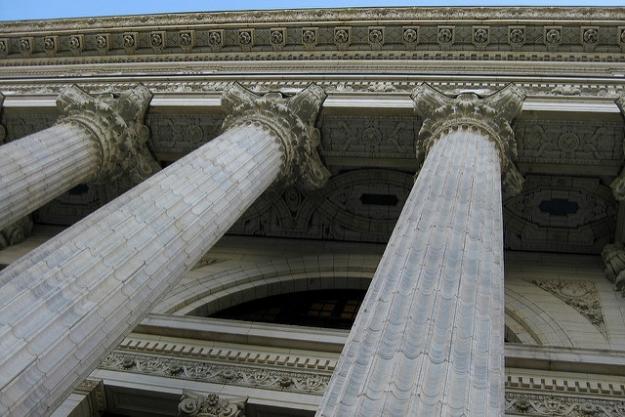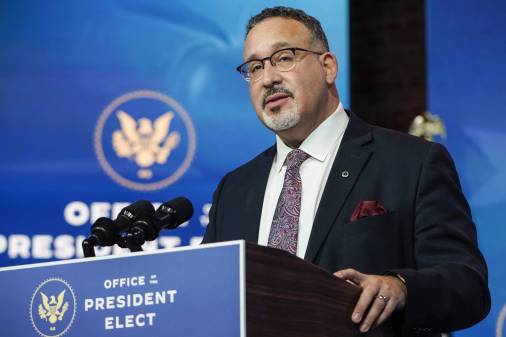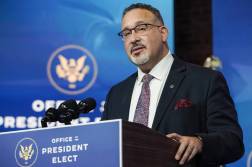Workforce is emphasis of White House proposal to combine Education, Labor departments

The Office of Management and Budget unveiled on Thursday a sweeping reorganization plan for almost every part of the federal government.
One of the very first proposals in the plan — and likely to be among the most contentious — is to combine the departments of Education and Labor, renaming the merged entity the Department of Education and the Workforce, or DEW.
Within the department would be four primary sub-agencies, focusing on K-12, Higher Education/Workforce Development, Research/Evaluation/Administration and Enforcement.
The stated objective would be to “help create alignment throughout the education-to-career pipeline, while also creating coherence within the workforce development and higher education worlds.”
One element in the plan — to “move to the Next Generation (Next Gen) Financial Services Environment … [which] would enhance operational components of Federal student aid programs, make it easier than ever to apply for financial aid from a mobile platform, and streamline the way that schools interact with student loan servicing and the repayment system” — builds on the administration’s earlier proposal to modernize FAFSA , a program used by tens of millions of Americans and housed in the Office of Federal Student Aid.
“President Trump campaigned and won with his promise to reduce the federal footprint in education and to make the federal government more efficient and effective,” Education Secretary Betsy DeVos said in a written statement. “Today’s bold reform proposal takes a big step toward fulfilling that promise. Artificial barriers between education and workforce programs have existed for far too long. We must reform our 20th century federal agencies to meet the challenges of the 21st century.”
The proposal has been met with skepticism in some quarters.
“My very first reaction is that this proposal is pretty unlikely to come to fruition,” Elizabeth Levesque, a fellow at the Brookings Institution’s Brown Center on Education Policy, told EdScoop. “It’s important to say at the outset that it would require legislation to make this change. I would be surprised if this is a high priority for members of Congress [or] whether they’d want to spend the political capital … at least in this session of Congress.”
Levesque said her second reaction is doubt about combining two departments with such different missions.
“In one of Secretary DeVos’ statements, she talked about tearing down unnecessary barriers between education and the workforce,” she said. “Building bridges between education and labor [makes sense], but those two different missions won’t just go away.”
Levesque said both agencies have numerous mandates they have to fulfill. She wondered how merging the two would bring them closer to meeting those policy goals.
For instance, she didn’t see anything in the proposed merger that would address the “skills gap” U.S. employers are lamenting, particularly in the areas of STEM, computer science or cybersecurity.
“I think that is a problem that requires a lot of different types of people working together, extending beyond just the folks in Washington at Labor and Education,” Levesque said. “Who’s going to be involved varies based on local context, [and] a lot has to happen at the state/local level … Laying out a policy framework [and] best practices could definitely help.”
‘A giant distraction’
Mary Alice McCarthy, director of the Center on Education and Skills at New America, a Washington-based think tank, and a former employee at both federal departments, also was dubious about the merits of merging them.
“I think it’s a giant distraction, it’s going to eat up a lot of people’s time, it’s not going to be successful, and it’s not going to help,” McCarthy told EdScoop. “There’s no question that we need to find ways to better coordinate our programs and investment in education and trying to figure out where these programs fit best … The way to make them more successful is not by moving desks around.”
She pointed out the needs of K-12 students are very different from adults looking for job training and said the Higher Education Act should be adjusted to reflect that many college students today are older and working. “Our community college sector needs to be better represented in the Department of Education,” she said. “That sector sort of straddles that education/labor divide.”
McCarthy dismissed the notion that combining the two departments would give any kind of boost to creating more students in computer science and STEM fields, two areas where both government and the private sector are looking for more skilled workers.
“The Office of Career and Technical Education has a new grants program out there, [a] nice marriage of workforce education and apprenticeship program,” she said. “That’s a good example, but they can do that without this reorganization … The [Education] Department says it’s pro-STEM, but I haven’t seen any indication of what they are going to do.”
McCarthy said there is no indication in the proposed reorganization that the administration has an investment strategy for specific issues, such as “creating more targeted investments in STEM fields and cybersecurity, delivered through community colleges or four-year programs. Those are investment strategies, not this reorganization.”
Some education groups reacted quickly and coolly to the proposal.
“The Trump administration’s plans to reorganize the federal government, including the possible radical merger of two federal agencies, the departments of education and labor among other changes, are at best ill-conceived and poorly timed and at worst are an attempt to distract the American public from the humanitarian crisis he created along the U.S.-Mexico border,” said Lily Eskelsen Garca, president of the National Education Association, in a statement.
Garca further characterized the announcement as “manufacturing distractions” to get the public to stop focusing on the issue of migrant children being forcibly separated from their parents.
Randi Weingarten, president of the American Federation of Teachers, also was dubious.
“In any normal administration, combining some of the core functions of the education and labor departments might make sense in terms of bringing together programs that educate children and prepare Americans for the jobs of today and tomorrow. Having workforce development — also known as adult education — in one department, and K-12, career and technical education, and college education in another, may not have made sense,” Weingarten said in a statement.
“But there is nothing normal about this administration, so we’re extremely skeptical of the motivations here given how hostile Betsy DeVos and President Trump have been to public education, workers and unions. It seems like this move is just cover for continuing their agenda to go after public schools, gut civil rights and equity protections, provide support for predatory student loan companies and prey on workers. We strongly oppose this move, and Congress should reject it.”
Reach the reporter at pwaitster@gmail.com and follow her on Twitter @edscoop_news .




